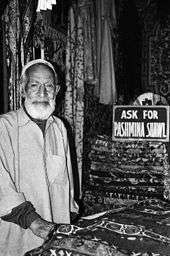Pashmina
Pashmina refers to a fine variant of spun cashmere, the animal-hair fibre forming the downy undercoat of the Changthangi goat.[1][2] The word pashm means "wool" in Persian, but in Kashmir, pashm referred to the raw unspun wool of domesticated Changthangi goats.[2] In common parlance today, pashmina may refer either to the material or to the variant of the Kashmir shawl that is made from it.[3] Both generic cashmere and pashmina come from the same goat, but generic cashmere ranges from 12–21 microns in diameter, whereas pashmina refers only to those fibres that range from 12–16 microns.[4]

History

The material gained prominence through its use in the Kashmir shawl. In Mughal times, this was used as an indicator of rank and nobility. In 1526, Babur (1483–1530) founded the Mughal Empire in India, and established the practice of giving khil'at (or "robes of honour", typically made of expensive fabric) to members of their durbar to indicate high service, great achievement, or royal favour.[5] In his time, the Mughal khil'at was a set of clothes, which could include a turban, long coat, gown, fitted jacket, sash, shawl, trousers, shirt, and scarf.[6] One or all of these could be made of pashmina and embroidered in gold cloth.[6] In 1568, Kashmir was conquered by Babur's grandson Akbar.[6] In Akbar's time, a pair of pashmina shawls were an expected part of khil'at ceremonies.[6] From the 16th to the early 20th centuries, the Safavid, Zand, and Qajar emperors of Iran also wore pashmina and gifted Kashmir shawls as khil'at within their political and religious practices.[6]
Pashmina blankets were also vital additions to a wealthy woman's dowry in India, Pakistan and Nepal.[7] In nineteenth-century English writing, despite the fact that shawls were worn by men, Kashmiri shawls became coded as women's luxuries. They acquired the status of heirlooms, worn by a girl on her marriage and coming-of-age,[8] and as heirlooms that women would inherit rather than purchase.[9] Since English law restricted women's abilities to inherit land, the Kashmir shawl served as an item of high exchange value that a woman could carry.[9] In France, the pashmina Kashmir shawl gained status as a fashion icon through Empress Joséphine's enthusiastic use.[10] These shawls suited the French well, providing the needed warmth, while adding visual interest to white French gowns through the traditional teardrop buta pattern and discreet floral motifs.[10] The shawl became a symbol of French bourgeois status from the Bourbon Restoration (1815–48) through the Second French Empire (1852–70). As a class marker, it fulfilled 19th century French tastes because it looked rich, had extensive ornamentation, artistic qualities, and was made of expensive raw materials.[6]
Production
Goats used for pashmina shed their winter coat every spring. One goat sheds approximately 80–170 gram (3–6 ounces) of the fibre. See also cashmere wool.
In the spring (the moulting season), the goats naturally shed their undercoat, which regrows in winter. This undercoat is collected by combing the goat, not by shearing, as in other fine wools. A traditional producer of pashmina wool in the Ladakh region of the Himalayas are a people known as the Changpa. These are a nomadic people and inhabit the Changthang plateau of Tibet, which has a lowest altitude of 13,500 feet above sea level and a winter temperature which can drop to −40-degree Celsius. The Changpa rear sheep in these harsh climates for meat, and pashmina goats for wool.[11]
Raw pashmina is exported to Kashmir. All steps from combing (removing impurities and guard hair, and aligning fibres) and spinning, to weaving and finishing, are traditionally carried out by hand by specialized craftsmen and women. The major centre of pashmina fabric production is in the old district of the city of Srinagar. The approximate time put into producing a single traditional pashmina stole (70x200cm) is 180 hours.
China accounts for 70% of the world cashmere production, Mongolia 20%, the remaining 10% of production is in Afghanistan, Australia, India, Iran, Nepal, Pakistan, United States, the Central Asian republics and elsewhere. Only a small percentage of this production is the ultra-fine cashmere known as pashmina.[12]
Pashmina products

Pashmina accessories are known for their softness and warmth. They are available in a range of sizes, from "scarf" 12 in × 60 in (0.30 m × 1.52 m) to "wrap" or "stole" 28 in × 80 in (0.71 m × 2.03 m) to full sized shawl 36 in × 80 in (0.91 m × 2.03 m) and in rare cases, "macho" 12 ft × 12 ft (3.7 m × 3.7 m). Pure pashmina is a rather gauzy, open weave, as the fibre cannot tolerate high tension. The most popular pashmina fabric is a 70% pashmina/30% silk blend, but 50/50 is also common. The 70/30 is tightly woven, has an elegant sheen and drapes nicely, but is still quite soft and light-weight.
A craze for pashmina shawls, known as shahmina in Kashmir, in the mid-1990s resulted in high demand for the raw material, so demand exceeded supply. When these shawls rose into fashion prominence during the era, they were marketed dubiously. In the consumer markets, pashmina shawls have been redefined as a shawl/wrap with cashmere and cashmere/silk, notwithstanding the actual meaning of pashmina. Some shawls marketed as pashmina shawls contain (sheep) wool,[13] while other unscrupulous companies marketed artificial fabrics such as viscose and others as "pashmina" with deceptive marketing statements such as "authentic viscose pashmina".
The word "pashmina" is not a labelling term recognized by law in the United States, where it is considered another term for cashmere. According to the U.S. Federal Trade Commission:
Some manufacturers use the term pashmina to describe an ultra fine cashmere fiber; others use the term to describe a blend of cashmere and silk. The FTC encourages manufacturers and sellers of products described as pashmina to explain to consumers, on a hangtag, for example, what they mean by the term.
As with all other wool products, the fiber content of a shawl, scarf or other item marketed as pashmina must be accurately disclosed. For example, a blend of cashmere and silk might be labeled 50% Cashmere, 50% Silk or 70% Cashmere, 30% Silk, depending upon the actual cashmere and silk content. If the item contains only cashmere, it should be labeled 100% Pashmina or All Cashmere, by the Wool Act or regulations.[14]
See also
References
- "Cashmere | animal fibre". Encyclopedia Britannica. Retrieved 31 March 2020.
- Skarratt, Ben (August 2018). "From India to Europe: The Production of the Kashmir Shawl and the Spread of the Paisley Motif" (PDF). Global History of Capitalism Project.
- "Pashmina". Cambridge English Dictionary. Retrieved 31 March 2020.
- "Identification Guidelines for Shahtoosh and Pashmina" (PDF). US Fish and Wildlife Service: National Fish and Wildlife Forensics Laboratory, Ashland, Oregon. 2002. Archived (PDF) from the original on 27 March 2020. Retrieved 27 March 2020.
- Skarratt, Ben (August 2018). "From India to Europe: The Production of the Kashmir Shawl and the Spread of the Paisley Motif" (PDF). Global History of Capitalism Project.
- Maskiell, Michelle (Spring 2002). "Consuming Kashmir: Shawls and Empires, 1500-2000". Journal of World History. University of Hawai'i Press (on behalf of World History Association). 13 (1): 27–65. doi:10.1353/jwh.2002.0019. JSTOR 20078943.
- Reis, José; Varela, Gonzalo (October 2013). "Can Tourism Encourage Better Export Performance and Diversification in Nepal?". CiteSeerX 10.1.1.689.7307. Cite journal requires
|journal=(help) - Irwin, John, 1917-1997. (1973). The kashmir shawl. London: H.M. Stationery Off. ISBN 0-11-290164-6. OCLC 3241655.CS1 maint: multiple names: authors list (link)
- Daly, Suzanne. (2011). The empire inside : Indian commodities in Victorian domestic novels. Ann Arbor: University of Michigan Press. ISBN 978-0-472-07134-0. OCLC 617509005.
- Joséphine and the arts of the Empire. DeLorme, Eleanor P., Chevallier, Bernard, 1943-, J. Paul Getty Museum. Los Angeles: J.P. Getty Museum. 2005. p. 167. ISBN 0-89236-801-2. OCLC 57432294.CS1 maint: others (link)
- Prem Singh Jina (1996). Ladakh: The Land and the People. Indus Publishing. p. 258. ISBN 978-81-7387-057-6. Retrieved 5 August 2012.
- Shakyawar, D B; Raja, A S M; Ajay, Kumar; Pareek, P K; Wani, S A. "Pashmina Fibre – Production, Characteristics and Utilization" (PDF). Indian Journal of Fibre and Textile Research. Indian Journal of Fibre and Textile Research. Retrieved 11 May 2015.
Note this work uses the word pashmina to refer to cashmere in general.
- Franck, Robert R. (October 2001). Silk, Mohair, Cashmere and Other Luxury Fibres. Woodhead Publishing. p. 142. ISBN 1-85573-540-7. Retrieved 8 July 2008.
- "Cachet of Cashmere: Complying with the Wool Products Labeling Act". Bureau of Consumer Protection, Trade Commission. Archived from the original on 9 April 2014. Retrieved 11 May 2014.
External links




.svg.png)